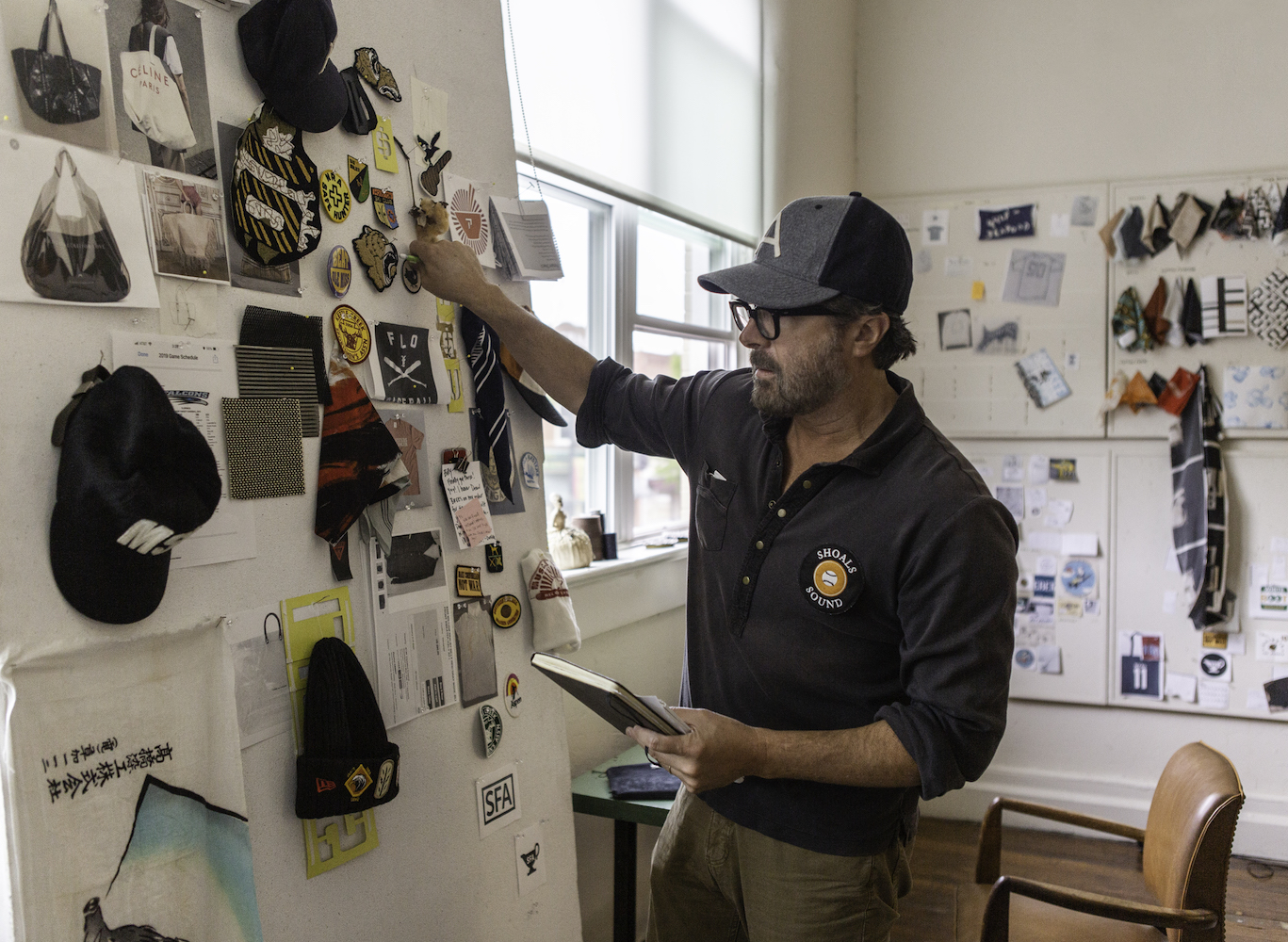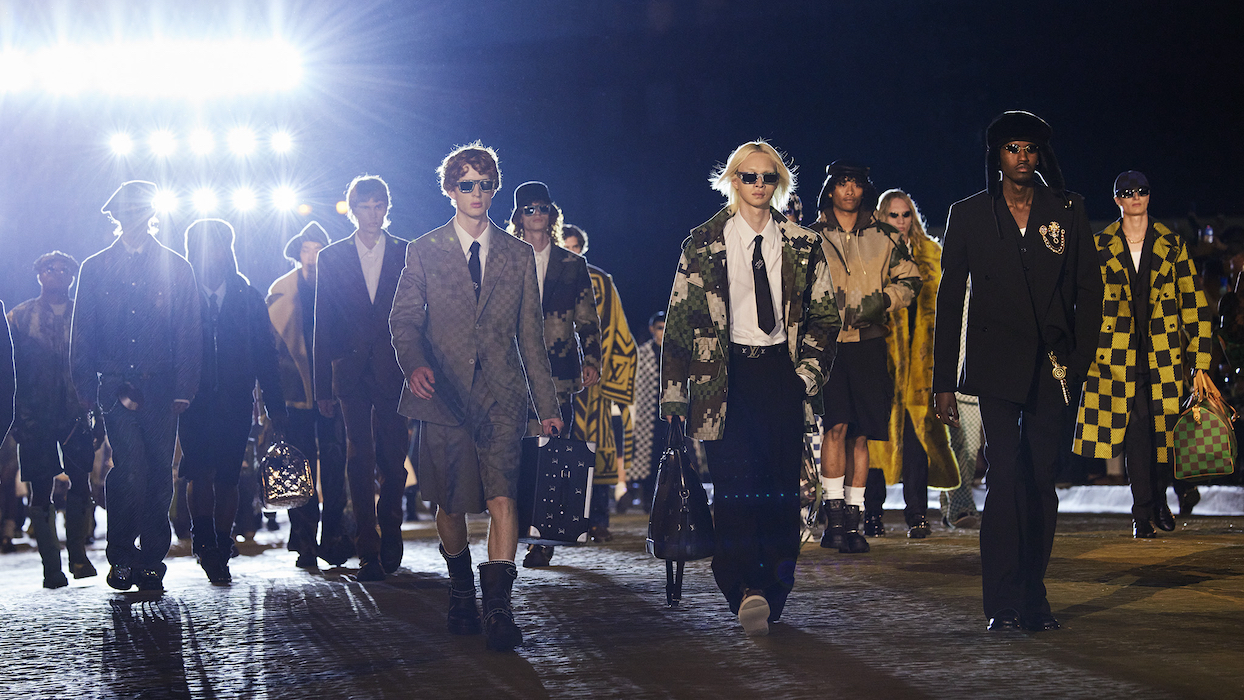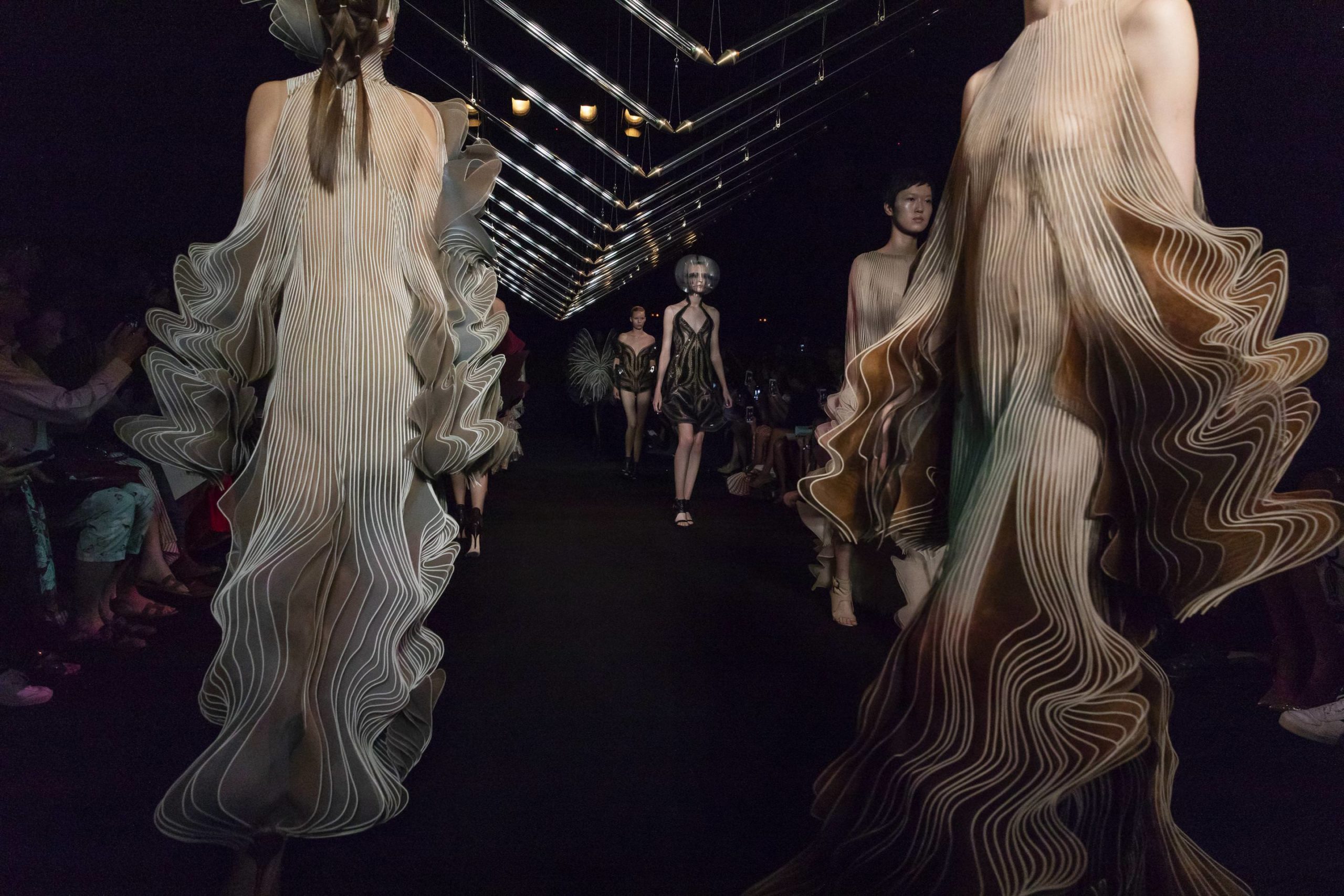The Alabama-born-and-based designer Billy Reid is the type of person you feel like you have known for years. Maybe it’s his Southern charm; maybe it’s his fashion’s lived-in luxury feel. Perhaps it’s his approach to collaboration or cross-pollination between cultures. Whatever the cause, it’s a feeling that makes a Billy Reid store or garment seem familiar.
But that feeling is both a natural and thought-out approach Reid has mastered since he launched his eponymous label—originally named after his formal full name, William Reid—in 1998. Back then, he embodied an effortless strategy to retail that was modeled after his mother’s. As a kid growing up in Amite, Louisiana, Reid learned a lot about fashion and flare from his mom who owned a boutique of her own. It operated out of her mother’s home, with a kitchen in the back, and became a gathering place for those looking for style and a great host. Decorated with personal furniture and objects, Reid’s mother’s store elicited the encouragement to shop, yes, but more importantly to stay a while.
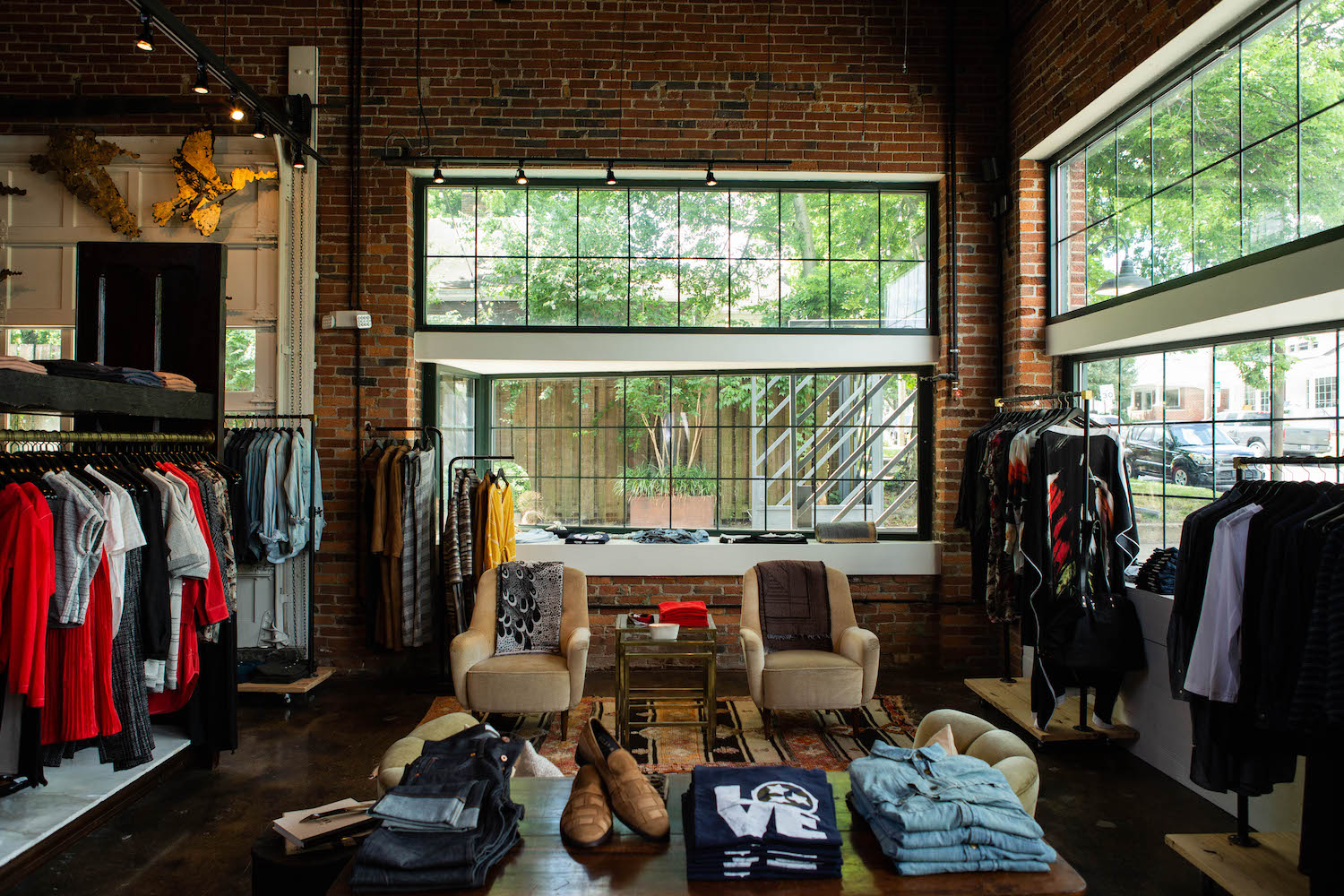
Billy Reid’s Nashville store, courtesy of Billy Reid.
Today, Reid’s 15 stores embody a similar blend of personal and professional interests. Stores are filled with furniture pieces the designer hand-picks—plucked from his home, found in estate sales, and more. Art that decorates the space is similarly presented, acting as a rotating exhibition of works Reid personally likes or supports, collects at home, and wants to display in various locations, too.
This season, for Spring/Summer 2022, a renewing emotional response was evoked in an array of clothing and accessories in a collection that whispered, “Let’s hit the road.” The way a long, secret street leads to a local spot, Reid wanted to invite us to get back out there, sparked by much isolation amid the pandemic.
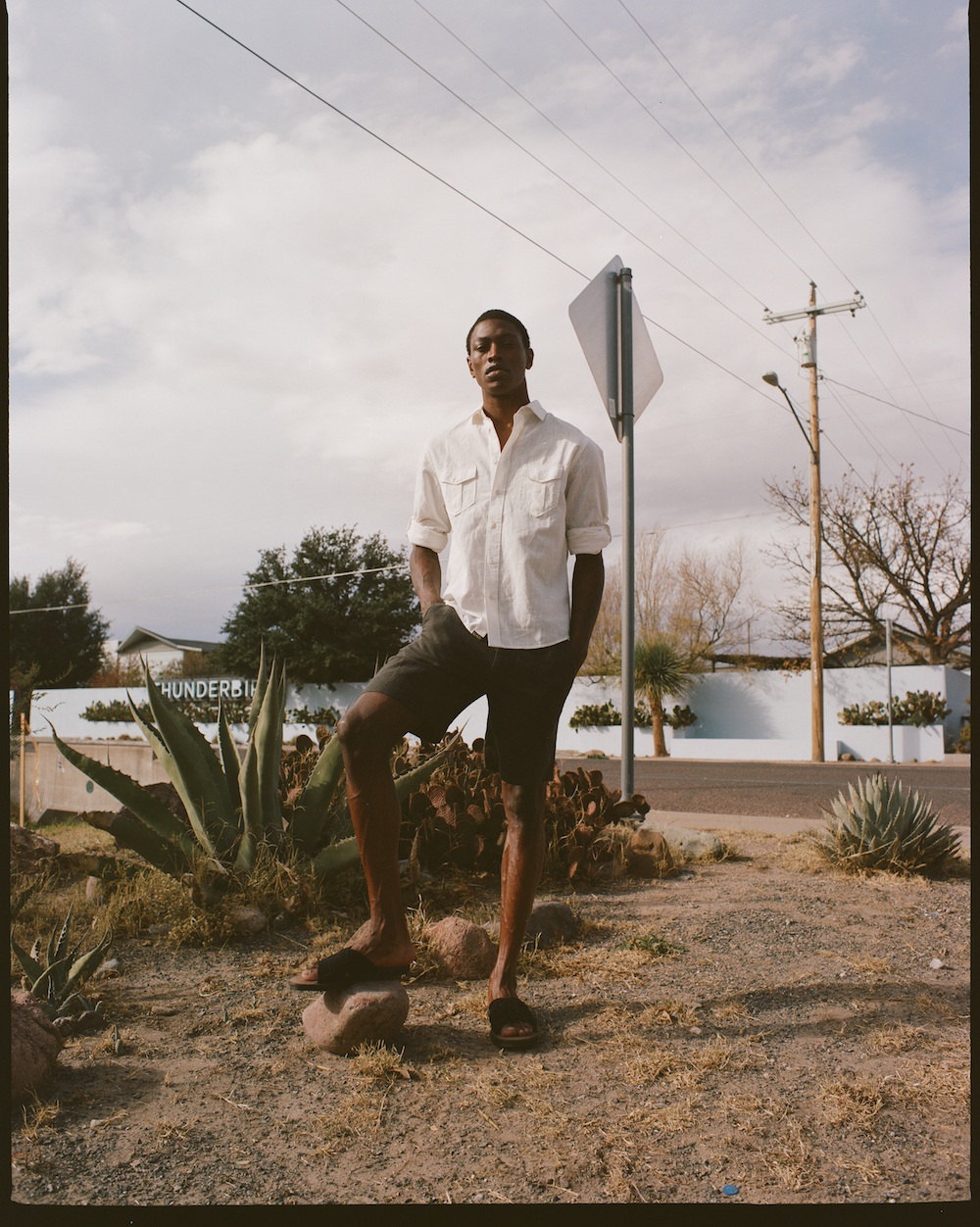
Billy Reid’s Spring/Summer 2022 collection, courtesy of Billy Reid.
Comfortable pieces like elevated chore coats and casual trousers are seen topping linen shirts and breezy button-down dresses. Suede zip-up bombers in red clay hues are there for cool summer nights; and loose-fitting tops are easily worn with sleeves rolled up, ready for their wearer to hit the road.
Special for this season, as well, is a collaboration between Billy Reid and the Nashville-based guitar-making company Gibson. As an ode to the designer’s love of music, which has been brewing since he started playing guitar at 12 years old, a selection of limited-edition styles has been released. Inspired by Gibson’s Hummingbird guitar, the line includes embroidered denim shirts, crewneck sweaters, cardigans, blankets, hats, scarves, and more.

Courtesy of Billy Reid and Gibson.
In celebration of his upcoming Fall/Winter 2022 collection, Whitewall spoke with Reid via Zoom about how his relationship to art and design impacts his choices in fashion, and what category we may see him venturing into next.
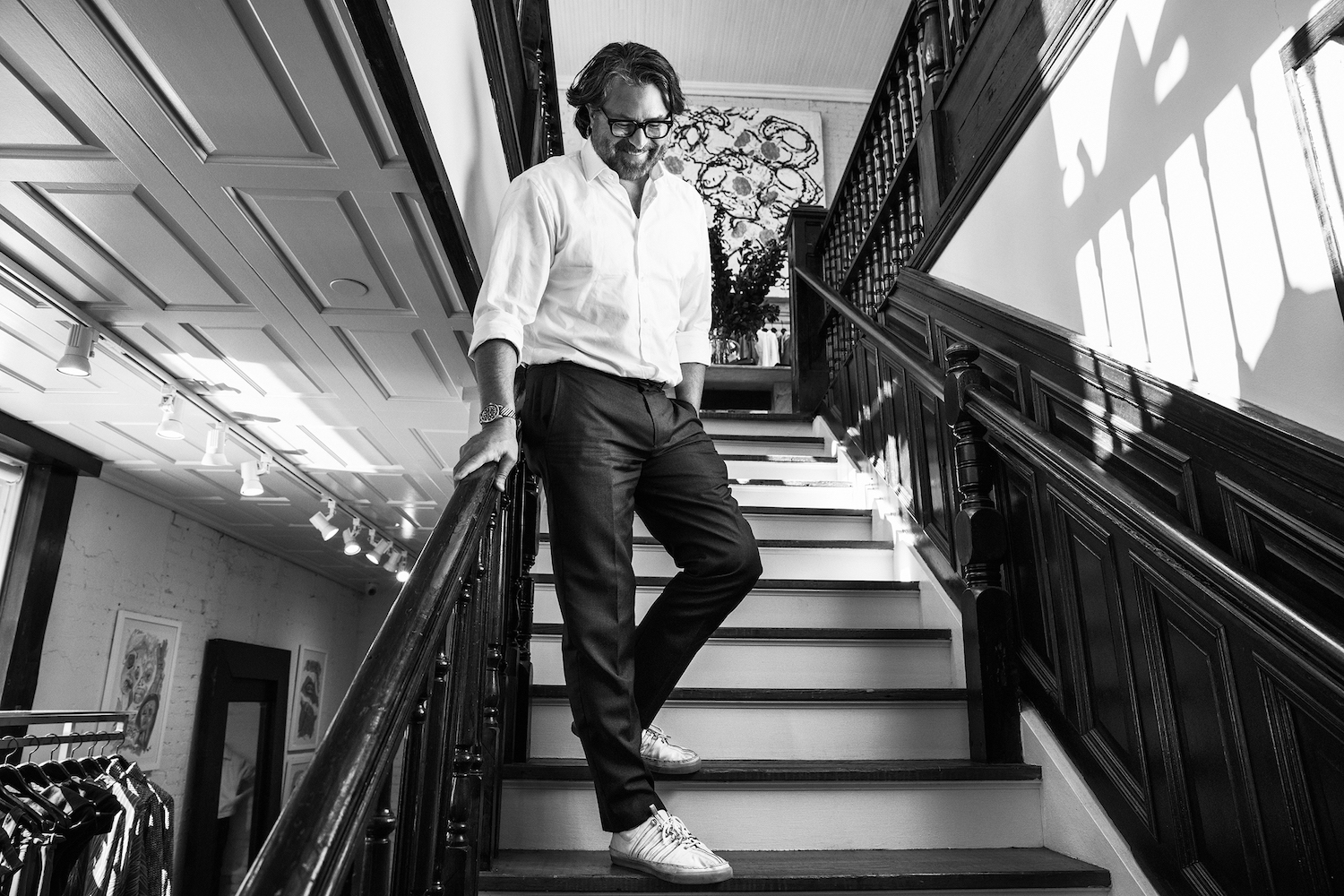
Courtesy of Billy Reid.
WHITEWALL: Can you walk us through your relationship with art, and how that impacts what we see in your stores? How did this type of personal sourcing and showcasing begin?
BILLY REID: When we first started building out the stores and decorating them, we started with nothing. But we wanted the shops to have a little bit of a residential feel to them, where you felt like you were walking into somebody’s house. One of the easiest things to do when you’re trying to make that happen is to take things from your house and bring them to the store. So, it started a little bit like that. There was so much back and forth between those two spaces to get it going, and it worked.
As you start to have more shops and interiors, and the fact that we may actually want furniture in our house and not just in the store, that evolves. It always has been this balance of found objects, new things, and things we make—whether it’s furniture pieces or lighting. It’s always been those three things happening at one time. And that home or residential feel does create a kind of hospitality, where it’s almost like someone’s coming to your home for whatever social thing you have going on at the moment, yeah. So, that’s kind of been the mindset, and we’ve kind of kept that. And through all that, we’ve met so many great artists and friends, and discovered so many cool things.
I was just coming back from Nashville recently and there’s this crazy place where I found fiberglass chairs for like five bucks. They had work by this lady, Betty, whose last name I couldn’t even read, with racks and racks of her charcoals displayed, hanging on pant hangers. They were five dollars each, and I bought like 30 of them. We put them in the stores and I have a few in my house. Really cool stuff! I also found these church pews in New Orleans—20 black walnut, hand-carved church pews that came out of this Baptist Church in Vicksburg, Mississippi, that was built in 1850. We found 20 of them and used them as paneling. I’ve also made benches out of them. So, it’s taking those kinds of things and making it fit whatever else is going on.
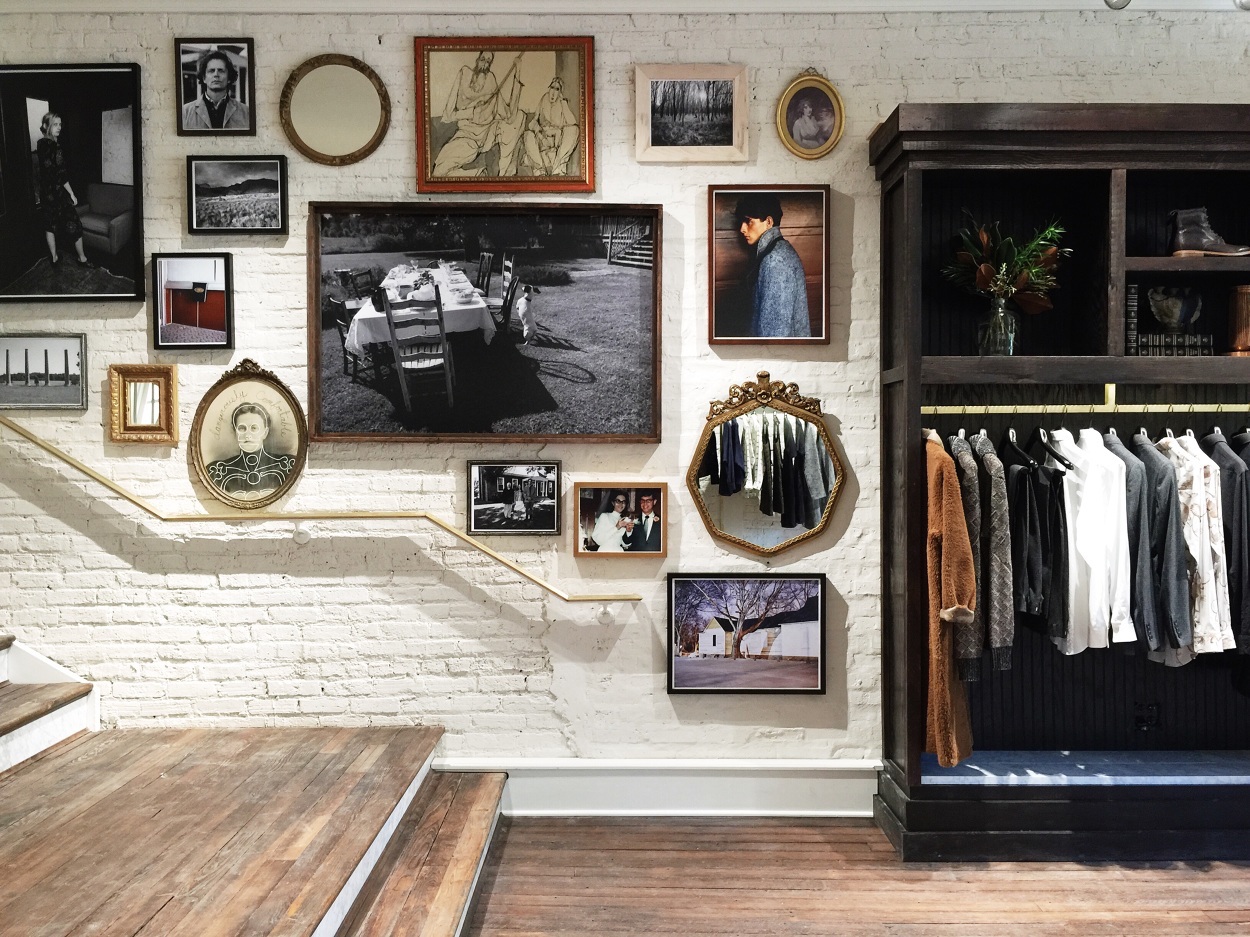
Billy Reid’s Chicago store, courtesy of Billy Reid.
WW: You have an affinity for found materials and the repurposing of them. Do you feel your clothing embodies a similar feel—an appreciation for old and new? Lived-in luxury?
BR: It’s good to hear you describe it that way because it’s not something that’s on purpose. That mindset just kind of carries over. It’s not something we think about. But we do want people to live in the clothes, and it’s kind of good when they put it on and it already feels like it’s that way. I think that creates something that’s very ageless—and something you could have, like a chair, that’s going to live with you. I think that just happens, and it definitely connects to the environment, too.
WW: What’s seen in your home?
BR: Well, a lot of things you’ll see in the shop. [Laughs] There are some of the same artists—like Butch Anthony, who certainly has a similar spirit of Thorton Dial—a really cool Alabama artist who was discovered in the ‘60s, I believe. He would take things that were around him and turn them into art. Butch does that same thing. He’ll paint over other paintings and take found objects—whether it’s metal or a wooden clog—and turn it into this incredible sculpture. He took these beaver sticks and made this teepee-looking structure out of them; they’re completely gnawed and clean. And I found this kind of mid-century three cone-shaped stemmed lamp and took his piece and then put the lamp into. You can almost see the bite marks and sticks, and then I added the lamp. His stuff is fantastic.
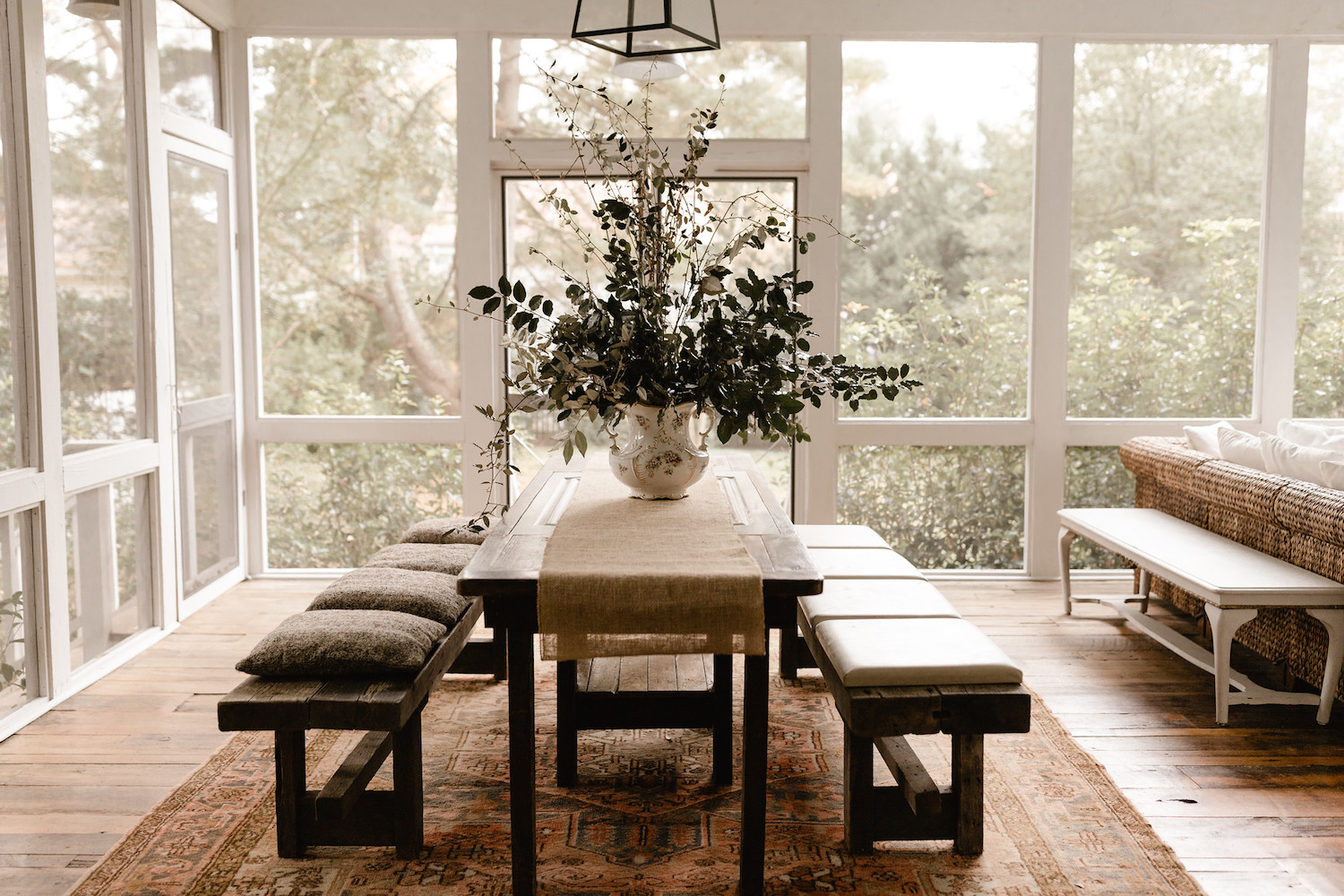
Courtesy of Billy Reid.
WW: You’re a fashion designer, but as we can see from the pieces you’ve made for your home or your stores, you’re also an artist. Do you ever consider yourself to be a more traditional industrial designer or a sculptor?
BR: You know, I love doing those things. I think it’s just a part of me. It just kind of carries over. love making those things, but I’ve never really thought of it as a category so to speak, but I really love working on it.
WW: Will we ever see a home accessory or décor line from you?
BR: Hopefully, eventually. You know, I more so just love doing it. But hopefully, we can put our own perspective on it, which can give it a place to kind of live on its own.
It’s just so much of an experiment, but I constantly look at things and think about what you could make with it, or how you could make it useful. In some ways, it’s the balance of having a piece next to a more modern chair or. Like, how do you combine it all?
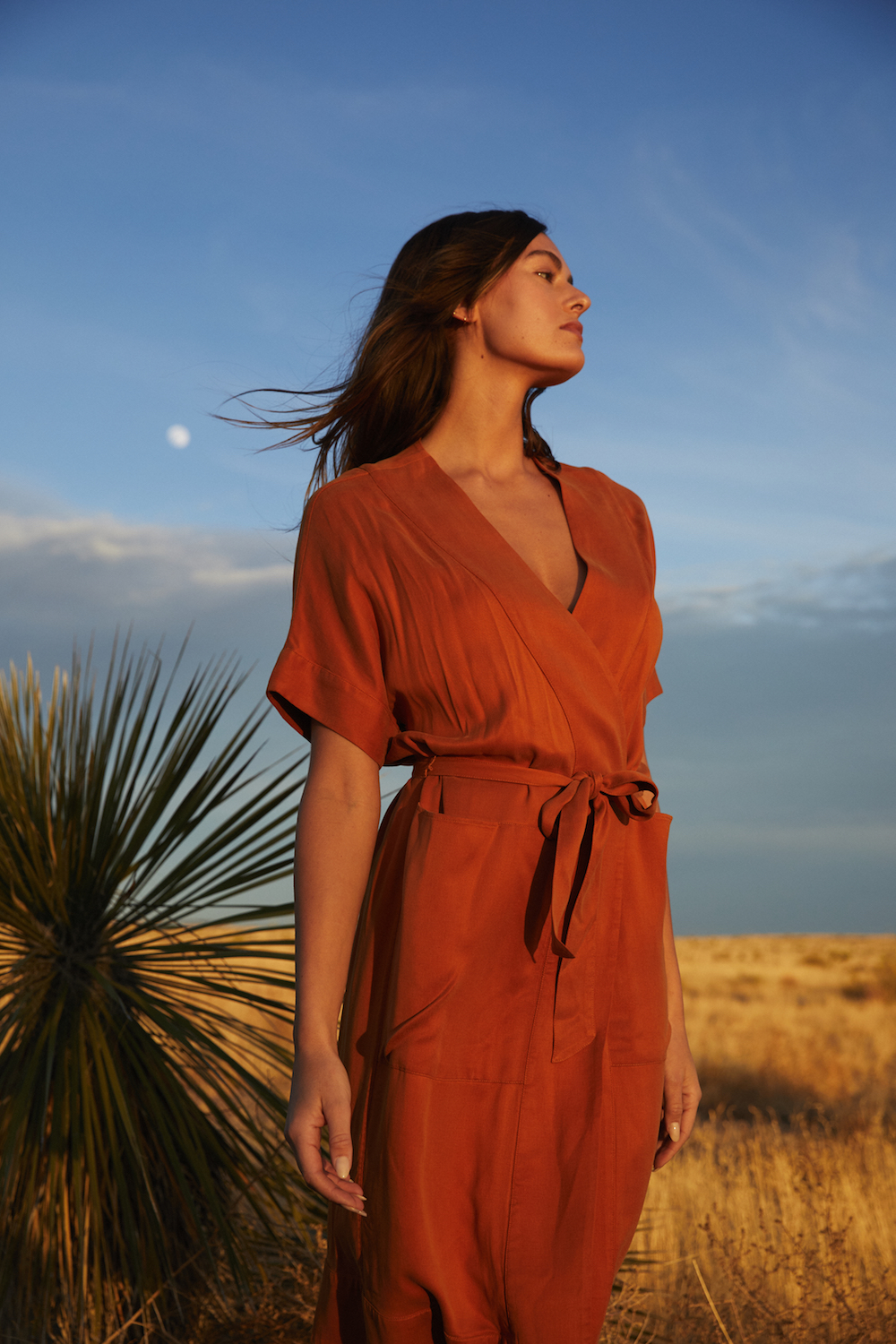
Billy Reid’s Spring/Summer 2022 collection, courtesy of Billy Reid.
WW: We’re still dealing with the ongoing pandemic. How has it made you think about what you’re designing now for a different kind of wardrobe?
BR: Some of our comfy, easy-to-wear type of things—like the chore jacket or a soft sport jacket—are things that we’ve made all along. It’s not something we just started to do. The materials that feel like they’ve been broken in, they’re soft to the hand—that’s always a good place for us to be.
During the pandemic, I think we all had a lot of reflective moments. For us, we asked, “Why are we successful? Why are we here? What do we do best? What do people expect from us? What has worked, What hasn’t worked?” And we took those things in, and it came down to a lot of those things—like incredible fabrications, and pieces you’re going to have for a long, long time. And hopefully making someone’s favorite piece. I think that approach is a good place for us to be.
In regard to categories, we’ve seen a shift, but we’ve seen a good reaction, especially in menswear, for things like tailored jacket. We’ve seen it in women’s, too. It’s still there. People are starting to go to weddings again, starting to go to cocktail parties again. That means in men’s, you’re going to need a jacket. And it’s probably been a while since you bought the last one because you’ve been sitting in front of a damn computer screen for the two years, wearing a shirt, and sitting in your boxer shorts. You can see that there is a slight shift,
But every five to seven years, the industry declares the death of the suit; the death of the sport jacket. We’ve heard that conversation a lot of times and it’s still there. Sales might go up a bit and down a bit, but I do feel like in those categories, you have to make things that are purposeful and versatile. Things that people can get a ton of wear out of.
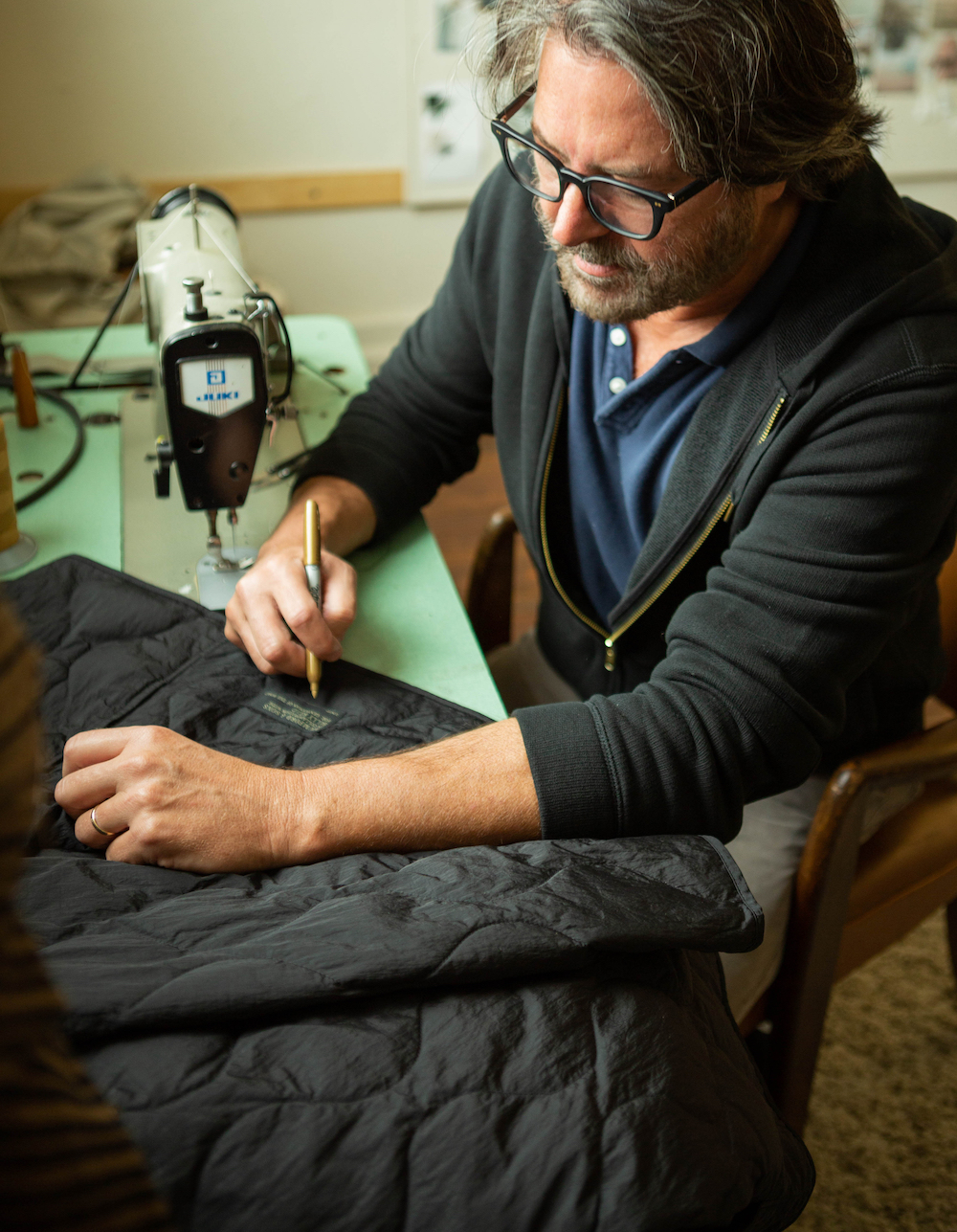
Courtesy of Billy Reid.
WW: Was there a piece in your last Fall/Winter collection that exemplified that?
BR: There was this double-breasted plaid tweed coat. It’s almost like a cardigan. That piece and that fabric really exemplifies that pretty well. It’s a little bit more of a statement piece, with it being plaid, but it’s got a lot of those characteristics to it. There’s also a boiled wool coat that we have that has a little bit of a knit quality to it, so it’s almost like wearing a sweatshirt, but it’s a coat. Those types of things are what people respond to well from us.
WW: This season, Spring/Summer 2022 embodies a new type of feeling. Is that how you wanted to approach it, with people not staying inside as much?
BR: Yeah, we’re actually trying to get out! [Laughs] We’ve had to think about that far in advance. We were feeling pretty cooped up, but thought, “Man, by the time this comes out, we’re going to want to get out and see some old friends and reconnect with people.” We started with this idea of taking a road trip to Marfa, and reconnecting with some folks out there in the Texas desert. We wanted to see how that affected things, and how that whole vibe happened in Marfa, and how we could bring it in. Then we went up into the highlands in the Carolinas, and thought about hanging out in those areas. It was about reconnecting with friends in different places—Kiawah Islands and Charleston, and low country-like places. It was this idea of taking a road trip and hitting multiple spots, three different terrains.
We looked at inspirations like basket weaving in the low country, which was going on there for a few hundred years probably, and thought about how to take those textures and use it as an idea to do our own sort of knitting techniques with that influence. We wanted to connect some of that.
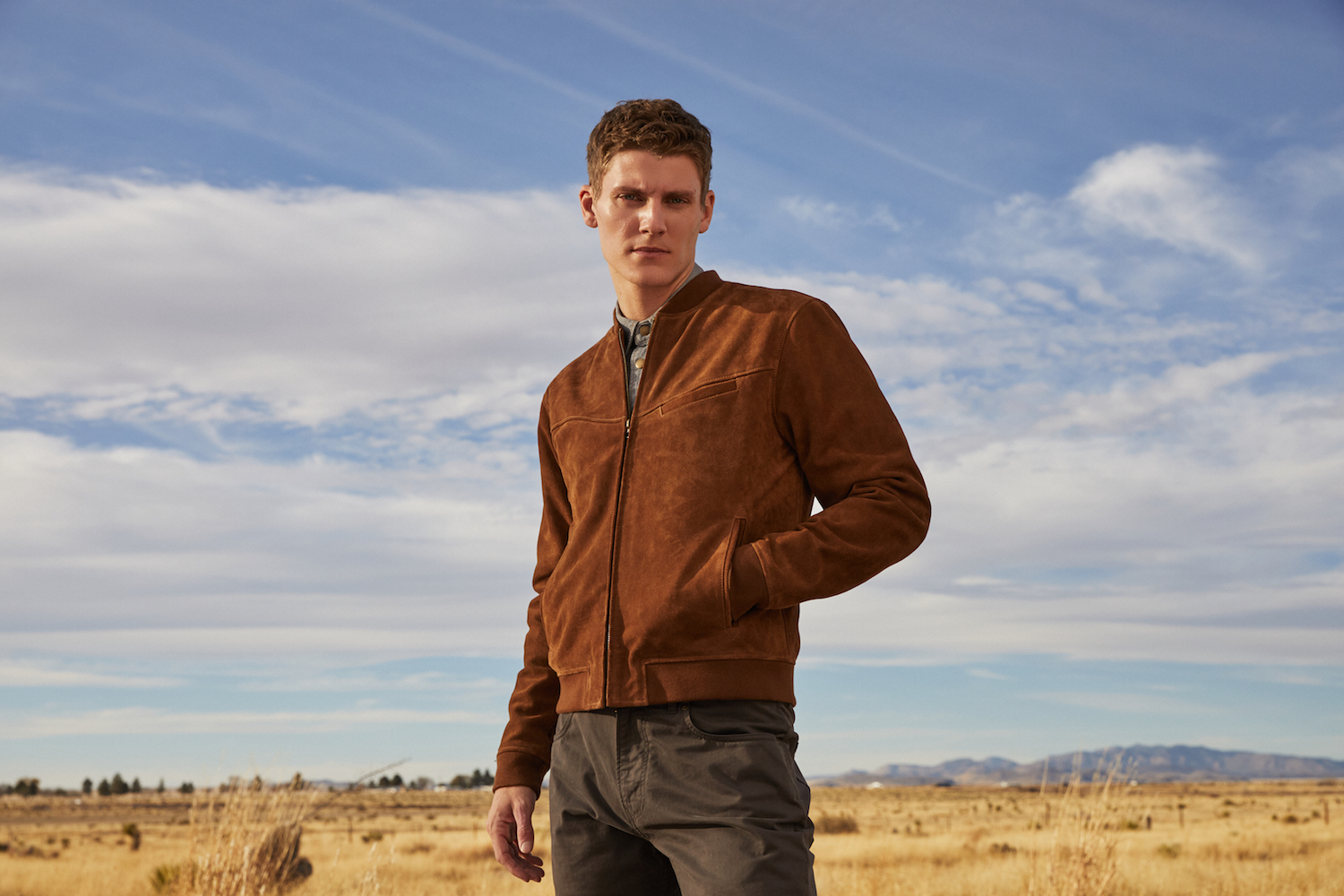
Billy Reid’s Spring/Summer 2022 collection, courtesy of Billy Reid.
WW: You’ve mentioned being inspired by remote places, as well as big cities. How do you balance that for a clothing line with a small-town feel but with a global approach?
BR: You have to trust it. And you have to be yourself. I’ve definitely learned that through the years of doing this. We keep it real, and that’s super important. People see right through it if it’s not. I personally have had the opportunity to live in other places—like Los Angeles, New York, and Boston—and have traveled.
Having those experiences helped balance me out, subconsciously, and form my own individual style. So, it’s about asking how to take that and put it into the product. You have to trust that—and hopefully folks like it. The idea is that you could feel comfortable wearing that shirt or coat or dress at the Rivertown Coffee Shop in Florence as you would at some someplace in Brooklyn or Silverlake. A piece has to be able to travel because our customer travels.
WW: When you’re traveling, how do you approach what you wear?
BR: When I go on a trip, I usually grab my favorite things. I know I’m going to grab that white shirt, that black knit, this sport jacket, these pants. I’m not taking a lot, but I’m usually grabbing things I feel most comfortable wearing—unless it’s an occasion, which is a little different. I don’t know if that’s how most folks think when they travel, but that’s certainly my approach to styling myself when I travel.
WW: How would you describe your personal style?
BR: Pretty simple, to be honest with you. My wife definitely criticizes me because when she goes to the closet, she says I only have shirts that are white, black, navy, or grey. She’s like, “There’s no plaid!” There’s no nothing. I’m pretty simple. I definitely care about those little details. There are certain jeans and brands and things that we make that I like, but I’m very simple. I love things that are somewhat classic, but updated, easy, and versatile.
I’ve got a pair of grey trousers that I wear all the time, and they were one of the first pair of pants I ever made. They’re like 22 years old. You could easily put them in the store right now and they’d be right on point. Those are the types of things I like.
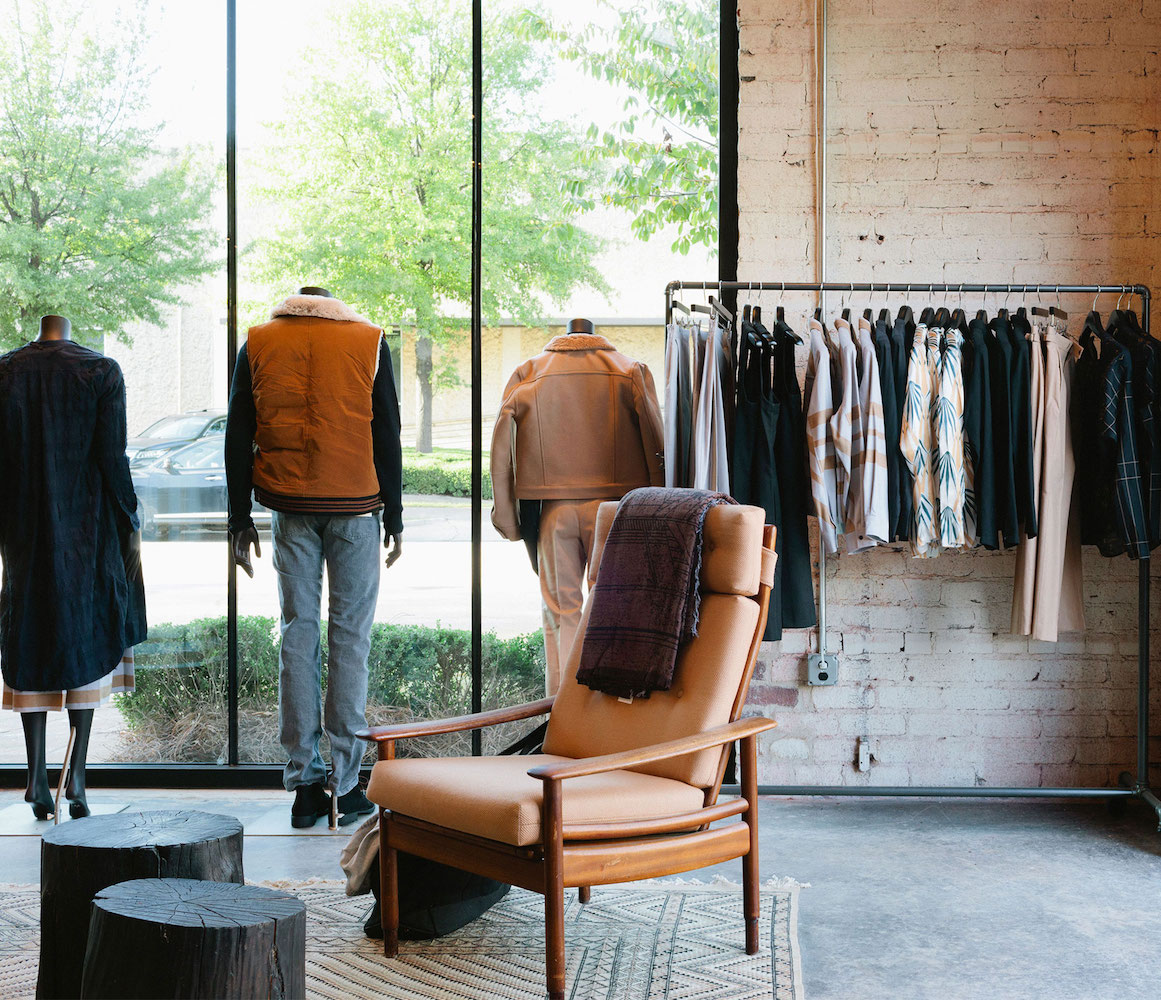
Billy Reid’s Birmingham, Alabama store, courtesy of Billy Reid.
WW: Sometimes when we’re lucky, you play off of old styles for updated renditions. Is there a piece from the past that you’ve gone back to that sells well today?
BR: To this day, our best-selling shirt is a denim shirt we first made in 2001. It’s had a few different iterations, but it’s almost the same shirt. We have a lot of other pieces like that—moleskin jeans, a pea coat—so it’s always a good place to start. It doesn’t mean you can’t step out and do new things, but it’s good to have a thread of consistency.
WW: I own one of your silk button-down dresses that features a thick chevron print in blue and gold, and it feels very approachable, yet almost all of your prints feel visually fluid. How are prints they created?
BR: Well, for that particular dress, I found these two matching lightweight cotton pieces from the ‘30s. They were hand painted, chevron pieces—like five feet long and three feet wide. It had a similar pattern on it, you know, but not that big. They had these little beads on the bottom. Do you remember those stores called Stuckey’s? The little gift shops on the side of the road that had these little tomahawks and bongos and drums. And you might find these two little Native American scarves. I have a vision of them being in there—being in Stuckey’s. Anyway, we kind of manipulated the artwork, and the idea evolved and turned it into that dress over a lot of trial and error. But that’s that idea of found objects becoming something else. What do you see that it could be—and for today? How does it relate? And how does it relate to everything else going on?
WW: That relatability factor plays into your relationship with food, music, and even philanthropy, and we saw that overarching idea come to fruition in a collaboration you held with Mumford & Son’s. First you invited them into your archive to pick out a piece and get inspired by it, redesigning it, and then selling it for charity. How do you view giving back?
BR: When my mom had her store, she was always super community minded. Small town, with people and businesses that cradled the community. That’s something I learned from watching her. But it’s also with a lot of people that you meet—like Mumford. We’ve known them since they started, which is kind of a weird thing, and have become friends. They have the Gentleman of The Road Foundation and we wanted to find a way to work together because there’s a connection. It’s cool when there’s connectivity that’s real. And that’s how it was with the Southern Foodways Alliance. They were customers, and then we all got to be friends. We started talking about how we could do things together and it turned into so many great things. It’s just finding those things that are true to, and it should come from a spot where you’re connected to it. All giving is good, for the most part, but it’s good to do when you feel you’re really involved with it.
WW: When you’re back in New York, where do you like to hang out? Where should visitors to your store visit?
BR: Just like most New Yorkers, we stick to our neighborhoods for the most part. I definitely stay around the NoHo and East Village area, just because that’s where we are. I’m not there every day, so to know that I can go to The Smile for breakfast is something I want to do. I know I’m going to get pizza at John’s Pizza. And as far as art, I think the streets are where you see the cool stuff happening—and the people. I also love the photography museum, Fotografiska, which is close. And the Whitney’s not far.
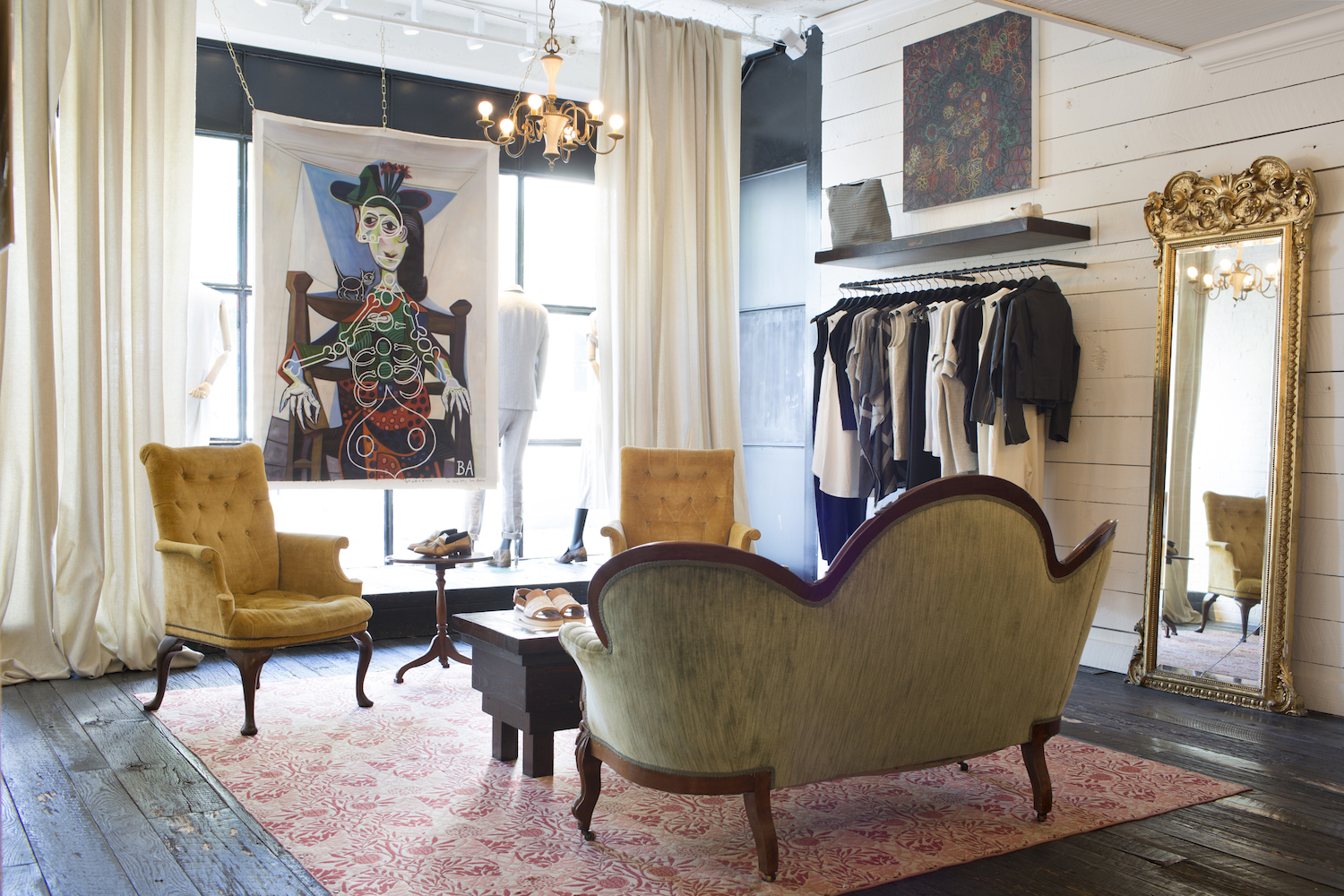
Billy Reid’s West Side, Atlanta, Alabama store, courtesy of Billy Reid.
WW: What about in Florence, Alabama?
BR: I would definitely come downtown. There’s a place called Trowbridge’s, which was established I think in 1918. It’s a sandwich and ice cream soda shop kind of place that has been there forever. The only thing that might have changed is the prices, and even they haven’t changed that much. It’s definitely a cool experience—with that small town something that’s been there you know type of spot. Rivertown Coffee is great.
You also definitely want to get some barbecue. Sledge’s is about 10 minutes outside of town, but well worth it. And Bunyan’s! And then we have Odette, which is a fantastic farm-to-table restaurant. Incredible bar, and the mix of what they offer there is fantastic. There’s a lot happening downtown; it’s hoppin’.
We also have a Frank Lloyd Wright house, which is one of the few in the south—the Rosenbaum house. If you have any time, I strongly, strongly suggest taking a look at that house. Well worth it. We did a presentation in there one time where we sculpted these mannequins and placed them all throughout the house and had a party there. Love that house. So, yeah, there’s your Chamber of Commerce pitch! [Laugh]
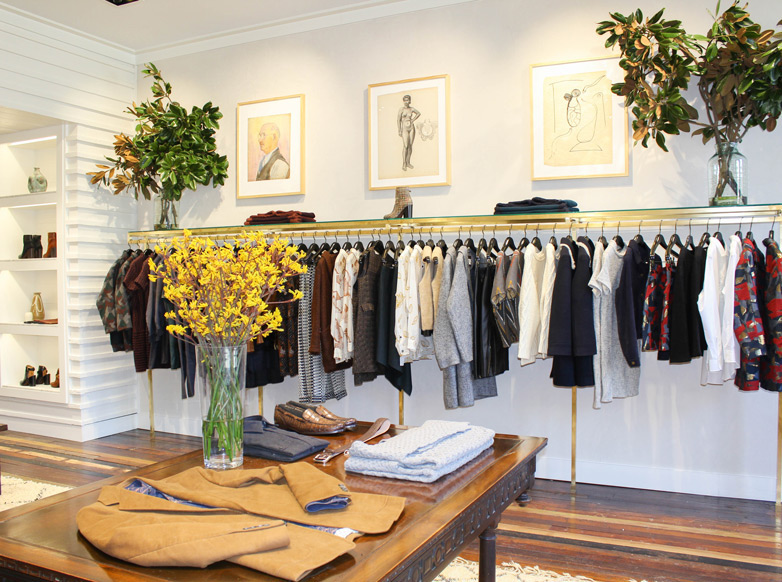
Billy Reid’s Buckead, Atlanta store, courtesy of Billy Reid.


